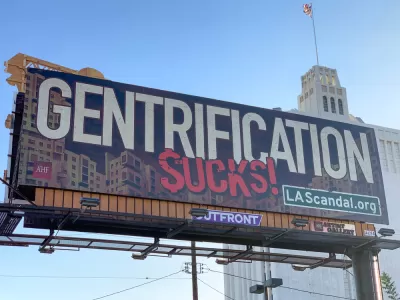Los Angeles has taken a rare step in anti-eviction action, considering the use of eminent domain to protect tenants of an apartment building in a gentrifying part of the city.

"[Los Angeles] Councilmember Gil Cedillo introduced a motion today asking city officials to make recommendations for how to acquire the Hillside Villa apartment complex in Chinatown using the process of eminent domain," reports Zoie Matthew. Located in a hot bed of development activity, "the building has been the subject of a heated battle between tenants’ rights activists and the property’s owner, Tom Botz, who has indicated that he plans to raise tenants rents to market rate once the property’s affordable housing covenants expire in September," according to Matthew.
The residents of Hillside Villa are far from alone among apartment complexes facing expiring covenants, so the Councilmember Cedillo has also floated the idea that eminent domain could be used in other situation sin the future.
The history of eminent domain in Los Angeles is full of examples of the power working to evict, not protect from eviction, notes Matthew. "In the ’50s, it was used to forcibly remove residents from the largely Latino neighborhood of Chavez Ravine to make way for Dodger Stadium. More recently, officials threatened to use it to clear out the remaining residents of Manchester Square to make room for LAX development."
Follow up coverage of this dramatic development in the narrative of displacement and affordable housing in Los Angeles is also available from David Zahniser for the Los Angeles Times.
FULL STORY: Will the City Buy Out Private Buildings to Protect Affordable Housing?

Study: Maui’s Plan to Convert Vacation Rentals to Long-Term Housing Could Cause Nearly $1 Billion Economic Loss
The plan would reduce visitor accommodation by 25,% resulting in 1,900 jobs lost.

North Texas Transit Leaders Tout Benefits of TOD for Growing Region
At a summit focused on transit-oriented development, policymakers discussed how North Texas’ expanded light rail system can serve as a tool for economic growth.

Why Should We Subsidize Public Transportation?
Many public transit agencies face financial stress due to rising costs, declining fare revenue, and declining subsidies. Transit advocates must provide a strong business case for increasing public transit funding.

How to Make US Trains Faster
Changes to boarding platforms and a switch to electric trains could improve U.S. passenger rail service without the added cost of high-speed rail.

Columbia’s Revitalized ‘Loop’ Is a Hub for Local Entrepreneurs
A focus on small businesses is helping a commercial corridor in Columbia, Missouri thrive.

Invasive Insect Threatens Minnesota’s Ash Forests
The Emerald Ash Borer is a rapidly spreading invasive pest threatening Minnesota’s ash trees, and homeowners are encouraged to plant diverse replacement species, avoid moving ash firewood, and monitor for signs of infestation.
Urban Design for Planners 1: Software Tools
This six-course series explores essential urban design concepts using open source software and equips planners with the tools they need to participate fully in the urban design process.
Planning for Universal Design
Learn the tools for implementing Universal Design in planning regulations.
City of Santa Clarita
Ascent Environmental
Institute for Housing and Urban Development Studies (IHS)
City of Grandview
Harvard GSD Executive Education
Toledo-Lucas County Plan Commissions
Salt Lake City
NYU Wagner Graduate School of Public Service




























